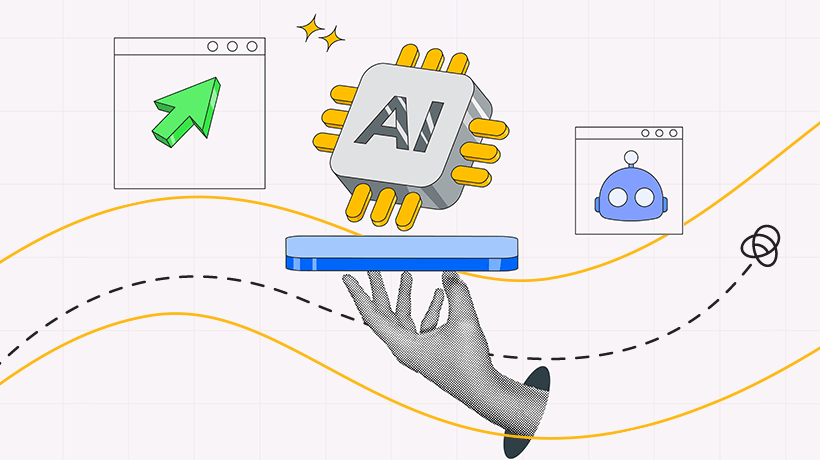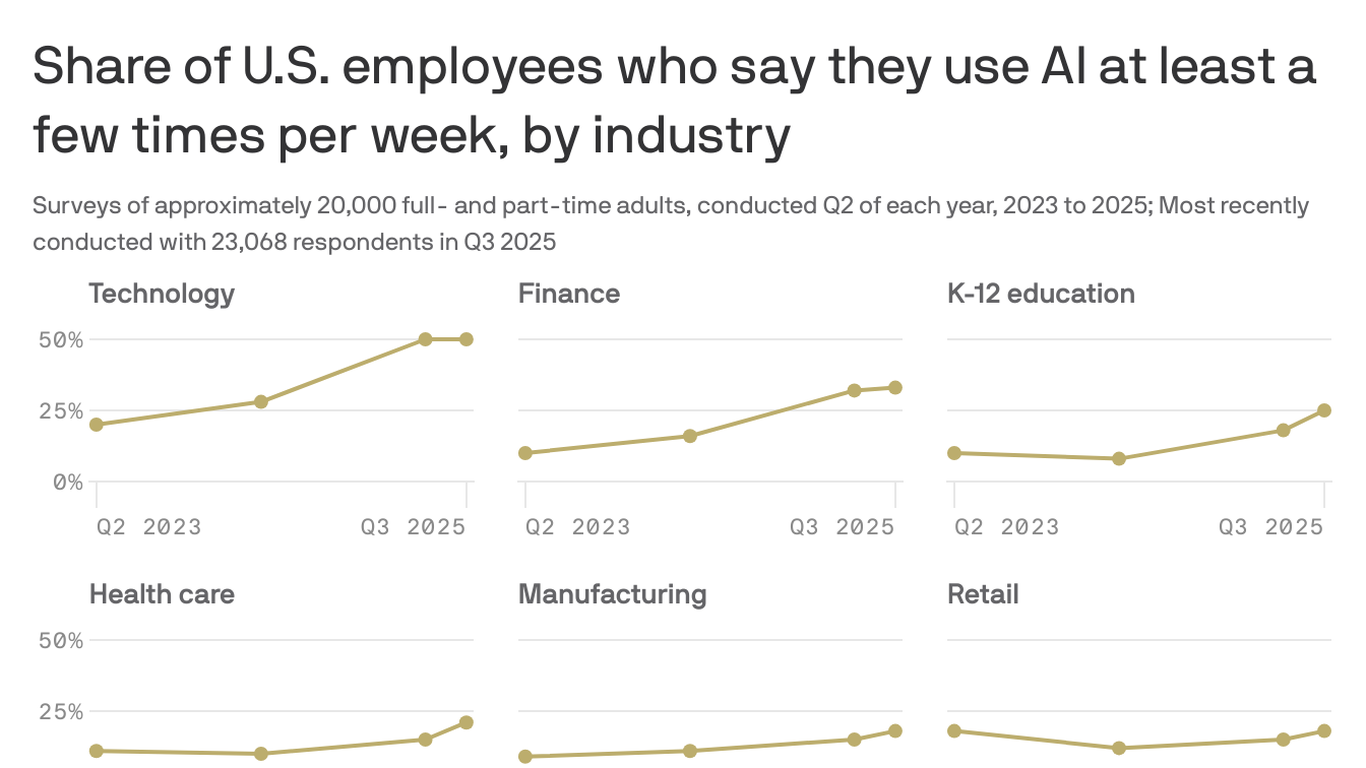#ai-adoption
#ai-adoption
[ follow ]
#chatgpt #generative-ai #workflow-automation #workplace-automation #llms #workforce-impact #enterprise-ai #openai
Artificial intelligence
fromAbove the Law
2 days agoLessons From The ABA's Second Report On The Next Phase Of Legal AI - Above the Law
AI adoption in the legal profession has outpaced practitioners' understanding, driving routine use now and cost-driven, firm-size-dependent expansion into complex work later.
Artificial intelligence
fromwww.theguardian.com
3 days agoWhen the AI bubble bursts, humans will finally have their chance to take back control | Rafael Behr
Rapid AI investment and adoption will reshape economies and daily life, with massive corporate bets risking a speculative bubble while building enduring infrastructure.
Artificial intelligence
fromFortune
3 days agoAn Iowa company that builds wood chippers doesn't care about your AI buzzwords: 2 Silicon Valley CEOs get real about the hype-slop-cycle | Fortune
Business customers want practical, measurable AI solutions that improve productivity and costs rather than hype; many still prefer human-in-the-loop.
fromMedium
4 days agoStop worrying so much about AI
Those who follow me on LinkedIn may have gotten the impression that I'm against AI. Nothing is further from the truth. What I'm really against is the notion that you can't do design without AI so you either learn AI or you're doomed. Using AI is of course useful for designers. But so is knowing how to use Figma and I put both of those in the same bucket of tactical skills.
UX design
Higher education
fromBusiness Insider
1 week agoUniversities risk becoming passive arms of Silicon Valley if they don't question how AI shapes truth, a professor says
Universities risk losing intellectual autonomy by adopting Big Tech AI systems that reshape definitions of knowledge, truth, and academic values.
Artificial intelligence
fromFortune
1 week agoIBM, AWS veteran says 90% of your employees are stuck in first gear with AI, just asking it to 'write their mean email in a slightly more polite way' | Fortune
Most employees use AI mainly as a basic search or microtask tool, preventing organizations from realizing productivity gains from advanced AI interaction modes.
Mental health
fromwww.npr.org
1 week agoPsychologists are increasingly using and worrying about AI tools, poll finds
More psychologists are adopting AI tools for administrative and clinical support, increasing efficiency while navigating ethical and educational integrity concerns for patients and students.
Artificial intelligence
fromFortune
1 week agoCan't get a job? Blame AI? Train in 'power skills,' IBM exec says: 'You can't hire a college student now to just come in and create a spreadsheet' | Fortune
By 2025, corporations accepted AI as core work infrastructure, shifting focus from novelty to widespread investment, urgent integration, and new workforce skill priorities.
Software development
fromIT Pro
1 week agoAI doesn't mean your developers are obsolete - if anything you're probably going to need bigger teams
AI adoption is expanding across software development and will drive larger teams through evolving platform engineering, despite increased compliance, security, and cost challenges.
fromFast Company
1 week ago'It made me a little bit kinder': How managers use AI to make decisions
Spikes embeds AI into his executive workflow. He likens it to how large firms use management consultants to map scenarios and risks, as well as act as a sounding board. He uses AI to help with complex decisions across people dynamics, situational gray areas, and selecting external partners or service teams: It could, for example, offer advice on handling disagreements between colleagues or partners, or offer alternate perspectives that challenge someone's initial point of view.
Artificial intelligence
Artificial intelligence
fromBusiness Insider
1 week agoHere are the top 5 most common ways people say they're using AI in the workplace
AI use at US workplaces has surged: 23% use AI weekly, with employees using it for data consolidation, idea generation, learning, automation, and problem identification.
Marketing tech
fromMarTech
1 week agoThe AI gold rush is over, and it's the orchestrators' time to shine | MarTech
AI adoption is shifting from gold-rush experimentation to production-focused orchestration emphasizing business integration, measurable revenue impact, and reputation-oriented risk management.
fromFortune
1 week agoThe fastest athletes in the world can botch a baton pass if trust isn't there-and the same is true of AI, Blackbaud exec says | Fortune
The U.S. Olympic men's and women's sprinting teams have won more gold medals than any other country in history, but the men's 4×100-meter relay team has suffered four blistering defeats in the past two decades. Why? An absolute whiff at the critical point when a runner has to instinctively reach back and trust their squadmate enough to perfectly place the baton in their hand.
Artificial intelligence
fromFortune
1 week agoThe AI skills gap is really a 'critical thinking' gap: The Fortune 500 fears it can't find talent with enough sharp thinking | Fortune
A new global survey encompassing the views of 1,540 board members and C-suite executives reveals that while corporate leaders are embracing artificial intelligence (AI) with optimism, a far more profound and existential talent crisis is emerging: the disappearance of the pathways that traditionally developed senior-level strategic expertise. AI is exposing not merely a lack of technical skills, but a critical thinking gap threatening the organizational pipeline needed to oversee and optimize these powerful new systems. In a moderated discussion with Joe Kornik, Senior Director, Editorial Programs, Protiviti, a series of experts and top executives from the consulting firm revealed the biggest concerns on executives' minds heading into 2026, during a lunchtime panel in New York City.
Artificial intelligence
Information security
fromIT Pro
2 weeks agoCyber budget cuts are slowing down, but that doesn't mean there's light on the horizon for security teams
Cybersecurity teams face a critical shift from headcount shortages to severe skills shortages, increasing breach risk despite slowing budget cuts and layoffs.
fromComputerworld
2 weeks agoAt Tractor Supply, investing in an innovation culture drives success
Tractor Supply, the No. 1 large company in this year's Best Places to Work in IT rankings, cultivates and reinforces its innovation culture through company-wide events as well as a broad spectrum of training and education programs. Tractor Supply IT employees are encouraged to spend time in-store to get first-hand experience in what frontline team members accomplish on a daily basis. Job shadowing lets IT staffers to explore new roles they may be interested in.
Artificial intelligence
fromFortune
2 weeks agoCursor developed an internal AI Help Desk that handles 80% of its employees' support tickets says the $29 billion startup's CEO | Fortune
Truell said the company had already automated roughly 80% of its customer support tickets with the help of the technology. He said the company had also implemented an internal AI-powered communication system that allows employees to query information across the organization. "We've actually done a lot of work internally on customizing that setup," he said. Cursor also uses AI for internal communications, he said. "We have a system where folks can ask any question about the company and get it answered by an AI," Truell said,
Venture
Law
fromAbove the Law
2 weeks agoBiglaw's Worst Enemy Isn't AI, It's Clients Using AI to Stop Paying Them - Above the Law
Corporate law departments are bringing significant legal work in-house, reducing projected outside counsel spend while adopting AI and reallocating resources to internal legal operations.
fromFortune
2 weeks agoMcKinsey's CFO: Why finance chiefs shouldn't hit pause on AI right now | Fortune
Following President Donald Trump's so-called Liberation Day, Atsmon said significant uncertainty emerged around the new administration's economic and geopolitical agenda. "If I look at the peak of uncertainty, what I was focused on as a CFO was: What are the things that I should be doing that would be helpful in any scenario?" Atsmon said. "The worst thing is inaction," he added. Acting on what you can control builds resilience, he said.
Artificial intelligence
fromBusiness Insider
2 weeks agoThe CEO of a McKinsey-backed employment nonprofit shares 4 ways leaders can implement AI effectively
Mona Mourshed has spent over a decade working on the future of work. As CEO of Generation, one of the world's largest employment nonprofits, operating in 17 countries and helping more than 140,000 people land jobs, she has a front-row seat to how companies are grappling with artificial intelligence. Her takeaway: Many companies are rolling out AI without a clear strategy.
Artificial intelligence
London startup
fromBusiness Insider
2 weeks agoI joined a company with an AI mandate. I was daunted at first, but I've saved hours by solving a big, boring problem.
An AI mandate requiring employees to generate half their output freed time by automating mundane tasks, enabling more focus on creative marketing and cryptogaming.
fromEMARKETER
2 weeks agoSMB marketers are using AI for landing page design more than any other optimization tactic
Key stat: 31% of US SMB marketers and business owners use AI-driven design or layout recommendations to optimize landing pages, according to a June 2025 survey from Ascend2 and Unbounce. Beyond the chart: The adoption mirrors broader B2B behavior. 95% of B2B marketers are using AI-powered tools in some capacity, with 89% specifically employing AI for generating marketing or written copy, according to an October Content Marketing Institute report.
Artificial intelligence
fromFortune
2 weeks agoElon Musk and Bill Gates are wrong about AI imminently replacing all jobs. 'That's not what we're seeing,' LinkedIn exec slams | Fortune
Companies adopting AI are increasing hiring for business development, tech‑savvy, and sales roles to capitalize on innovation and growth opportunities.
Soccer (FIFA)
fromBavarian Football Works
3 weeks agoBayern Munich news: FC Bayern building The Terminator on campus?; Arsenal, Liverpool, Manchester City, Manchester United, Chelsea, Tottenham Hotspur want Real Madrid's Rodrygo; and MORE!
FC Bayern banned ChatGPT and require employees to use a privately hosted, club-developed AI platform while top clubs monitor Rodrygo's potential transfer.
fromComputerWeekly.com
3 weeks agoConstrained budgets left security teams short-handed in 2025 | Computer Weekly
After a torrid 2024, the wider macroeconomic conditions affecting cyber security professionals showed signs of levelling off in 2025, with reports of budget cuts and layoffs to cyber teams dropping slightly this year after surging in the prior period. However, constrained budgets remain a key driver behind the ongoing cyber skills shortage. This is according to the annual Cybersecurity workforce study produced by cyber professional association ISC2, which polled over 16,000 security professionals to produce this year's report.
Information security
fromInc
3 weeks agoHere's How AI is Fueling Small Business Creation and Driving Growth
Concern over the potential of artificial intelligence replacing employees remains high as the number of work tasks the tools can tackle grows. But the technology now plays a large role in boosting employment, too. A new report by job site LinkedIn shows how AI does that by fueling small business growth, and enabling a rising number of aspiring entrepreneurs to strike out their ow
Artificial intelligence
fromIT Pro
3 weeks agoHow the UK is leading Europe at AI-driven manufacturing
According to a recent report from digital transformation and industrial automation provider Rockwell Automation, the UK already leads Europe in smart manufacturing, with 53% of its manufacturers using AI on the factory floor and 98% overall planning to implement it. This compares to a global average of 41% introducing AI and machine learning (ML), as well as 95% planning to implement.
Artificial intelligence
fromFast Company
3 weeks agoTrust, but verify: Leading in the age of AI overconfidence
No doubt you've noticed it-along with millions of others who now rely on AI for everything from planning product launches and rewriting emails to turning their beloved pets into cartoons. The adoption speed has been remarkable. In just a few years, AI has gone from a buzzword to a daily fixture in countless workplaces. And for many, it's already hard to remember what work looked like without it.
Artificial intelligence
Artificial intelligence
fromComputerWeekly.com
3 weeks agoSAP user group chair warns of AI low-hanging fruit risks | Computer Weekly
Businesses must adopt AI, low-code tooling, and process change to cut costs and deliver long-term enterprise software value, despite slow ROI and implementation complexity.
fromBusiness Insider
3 weeks agoThe secret to avoiding 'AI slop' - let workers 'job craft' their own roles around AI tools, researchers say
Employees who take the initiative to reshape their roles around artificial intelligence - rather than simply using it to speed through tasks - are more engaged, motivated, and creative at work, according to new research from Multiverse, the upskilling platform for AI and tech adoption. The study, conducted in June and July, analyzed 295 UK full-time professionals across industries, including finance, government, and technology, all of whom had used generative AI for at least six months.
Artificial intelligence
fromBusiness Insider
3 weeks agoGoogle Pixel's marketing VP says she was once a lifelong iPhone user
On the consumer side, one of the things we talk about from a Gemini perspective is the fact that it is easily integrated into our Google Suite, which we think is our biggest differentiator. We always lean into the ability to supercharge productivity as well as creativity, and being able to do that 10-fold if you compare it to the competitors in the marketplace, because we have an integrated stack.
Gadgets
fromFortune
4 weeks agoHow AI can power Europe's next industrial revolution | Fortune
Europe stands at a pivotal moment. On one hand, demographic pressures, energy market volatility and sluggish productivity are squeezing growth. On the other hand, the continent has an opportunity to reassert its competitiveness with the United States and China, which are taking the lead in strategic technologies such as AI. This matters because AI is arguably the most transformative technology for productivity in history.
Miscellaneous
[ Load more ]






















